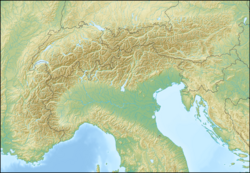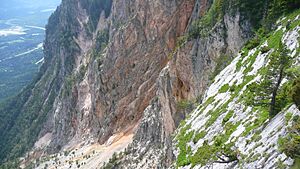1348 Friuli earthquake facts for kids
| Local date | 25 January 1348 |
|---|---|
| Magnitude | 6.9-7.1 |
| Epicenter | 46°22′N 13°35′E / 46.37°N 13.58°E |
| Type | Thrust |
| Areas affected | Italy (Friuli-Venezia Giulia) Austria (Carinthia) |
| Max. intensity | X (Extreme) |
| Casualties | 10,000 |
The 1348 Friuli earthquake was a very strong earthquake that shook parts of Europe on January 25, 1348. Its center was in the Friuli region, which is in modern-day Italy. This earthquake happened in the same year that the terrible Black Death plague spread across Italy.
People at the time wrote that the earthquake caused huge damage. Many churches and homes fell down. Whole villages were destroyed. Some even reported strange smells coming from the ground.
Contents
What Caused the 1348 Friuli Earthquake?
The Friuli region is a place where Earth's huge plates meet. The Adriatic Plate and the Eurasian Plate are slowly pushing into each other. This pushing creates a lot of pressure.
When this pressure builds up too much, the ground can suddenly move. This movement causes an earthquake. Scientists think the 1348 earthquake happened because of this plate movement.
How Strong Was the Friuli Earthquake?
The earthquake's epicenter was near the towns of Tolmezzo, Venzone, and Gemona. Scientists estimate its strength was about 6.9 on the Richter magnitude scale. This is a very powerful earthquake.
Where the Earthquake Was Felt
Most of the damage happened in Northern Italy. This included the Friuli-Venezia Giulia region and nearby areas like Belluno, Vicenza, and Verona. The shaking was also felt in Lombardy and Venice.
Further north and east, places like Carinthia in Austria and Carniola (now part of Slovenia) also felt the quake. Even far-off cities like Pisa and Naples reported feeling it.
Aftershocks and Their Impact
The main earthquake hit in the early afternoon. After the main shock, smaller earthquakes, called aftershocks, kept happening. These aftershocks continued until March 5, 1348.
The earthquake caused hundreds of deaths. Many buildings were completely destroyed. In the city of Udine, the castle and the cathedral were badly damaged.
In Carinthia, the town of Villach was mostly ruined. A huge landslide happened near Villach, followed by a flood from the Gail River. This added to the destruction.
Even in Rome, far to the south, the earthquake caused problems. The Basilica di Santa Maria Maggiore church was damaged. A tower called the Torre delle Milizie lost its top floor and now leans a bit. Another old church, Santi Apostoli, was so badly damaged it was left in ruins for many years.
The Earthquake and the Black Death
The 1348 Friuli earthquake happened at the same time the Black Death was starting to spread across Europe. People in those days often thought these two terrible events were connected. They saw them as signs from God.
Historians say the earthquake might have made people even more afraid of the end of the world than the plague did. Some people, like the writer Giovanni Villani, saw the earthquake as a warning. Others saw it as a reminder to live a good life.
The earthquake was written about in many old city and abbey records. This is why modern historians have been able to study the "Friuli event" so well.
See also
- List of earthquakes in Italy
- List of historical earthquakes
- 1511 Idrija earthquake



